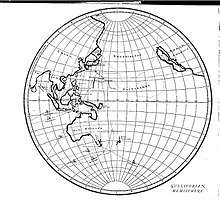Gulliver's Travels
Gulliver's Travels, or Travels into Several Remote Nations of the World. In Four Parts. By Lemuel Gulliver, First a Surgeon, and then a Captain of Several Ships is a 1726 prose satire[1][2] by the Irish writer and clergyman Jonathan Swift, satirising both human nature and the "travellers' tales" literary subgenre. It is Swift's best known full-length work, and a classic of English literature. Swift claimed that he wrote Gulliver's Travels "to vex the world rather than divert it".
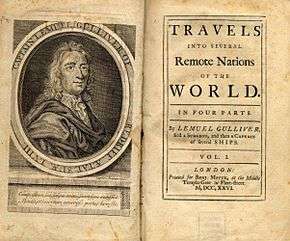 First edition of Gulliver's Travels | |
| Author | Jonathan Swift |
|---|---|
| Original title | Travels into Several Remote Nations of the World. In Four Parts. By Lemuel Gulliver, First a Surgeon, and then a Captain of Several Ships |
| Country | England |
| Language | English |
| Genre | Satire, fantasy |
| Publisher | Benjamin Motte |
Publication date | 28 October 1726 |
| Media type | |
| 823.5 | |
| Text | Gulliver's Travels at Wikisource |
The book was an immediate success. The English dramatist John Gay remarked "It is universally read, from the cabinet council to the nursery."[3] In 2015, Robert McCrum released his selection list of 100 best novels of all time in which Gulliver's Travels is listed as "a satirical masterpiece".[4]
Plot
Part I: A Voyage to Lilliput

The travel begins with a short preamble in which Lemuel Gulliver gives a brief outline of his life and history before his voyages.
- 4 May 1699 – 13 April 1702
During his first voyage, Gulliver is washed ashore after a shipwreck and finds himself a prisoner of a race of tiny people, less than 6 inches (15 cm) tall, who are inhabitants of the island country of Lilliput. After giving assurances of his good behaviour, he is given a residence in Lilliput and becomes a favourite of the Lilliput Royal Court. He is also given permission by the King of Lilliput to go around the city on condition that he must not hurt their subjects.
At first, the Lilliputians are hospitable to Gulliver, but they are also wary of the threat that his size poses to them. The Lilliputians reveal themselves to be a people who put great emphasis on trivial matters. For example, which end of an egg a person cracks becomes the basis of a deep political rift within that nation. They are a people who revel in displays of authority and performances of power. Gulliver assists the Lilliputians to subdue their neighbours the Blefuscudians by stealing their fleet. However, he refuses to reduce the island nation of Blefuscu to a province of Lilliput, displeasing the King and the royal court.
Gulliver is charged with treason for, among other crimes, urinating in the capital though he was putting out a fire. He is convicted and sentenced to be blinded. With the assistance of a kind friend, "a considerable person at court", he escapes to Blefuscu. Here, he spots and retrieves an abandoned boat and sails out to be rescued by a passing ship, which safely takes him back home.
Part II: A Voyage to Brobdingnag
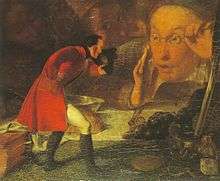
- 20 June 1702 – 3 June 1706
Gulliver soon sets out again. When the sailing ship Adventure is blown off course by storms and forced to sail for land in search of fresh water, Gulliver is abandoned by his companions and left on a peninsula on the western coast of the North American continent.
The grass of Brobdingnag is as tall as a tree. He is then found by a farmer who is about 72 ft (22 m) tall, judging from Gulliver estimating the man's step being 10 yards (9 m). The giant farmer brings Gulliver home, and his daughter Glumdalclitch cares for Gulliver. The farmer treats him as a curiosity and exhibits him for money. After a while the constant display makes Gulliver sick, and the farmer sells him to the Queen of the realm. Glumdalclitch (who accompanied her father while exhibiting Gulliver) is taken into the Queen's service to take care of the tiny man. Since Gulliver is too small to use their huge chairs, beds, knives and forks, the Queen commissions a small house to be built for him so that he can be carried around in it; this is referred to as his "travelling box".
Between small adventures such as fighting giant wasps and being carried to the roof by a monkey, he discusses the state of Europe with the King of Brobdingnag. The King is not happy with Gulliver's accounts of Europe, especially upon learning of the use of guns and cannons. On a trip to the seaside, his traveling box is seized by a giant eagle which drops Gulliver and his box into the sea where he is picked up by sailors who return him to England.
Part III: A Voyage to Laputa, Balnibarbi, Luggnagg, Glubbdubdrib and Japan
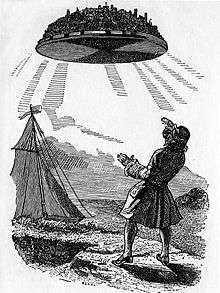
- 5 August 1706 – 16 April 1710
Setting out again, Gulliver's ship is attacked by pirates, and he is marooned close to a desolate rocky island near India. He is rescued by the flying island of Laputa, a kingdom devoted to the arts of music, mathematics, and astronomy but unable to use them for practical ends. Rather than using armies, Laputa has a custom of throwing rocks down at rebellious cities on the ground.
Gulliver tours Balnibarbi, the kingdom ruled from Laputa, as the guest of a low-ranking courtier and sees the ruin brought about by the blind pursuit of science without practical results, in a satire on bureaucracy and on the Royal Society and its experiments. At the Grand Academy of Lagado in Balnibarbi, great resources and manpower are employed on researching preposterous schemes such as extracting sunbeams from cucumbers, softening marble for use in pillows, learning how to mix paint by smell, and uncovering political conspiracies by examining the excrement of suspicious persons (see muckraking). Gulliver is then taken to Maldonada, the main port of Balnibarbi, to await a trader who can take him on to Japan.
While waiting for a passage, Gulliver takes a short side-trip to the island of Glubbdubdrib which is southwest of Balnibarbi. On Glubbdubdrib, he visits a magician's dwelling and discusses history with the ghosts of historical figures, the most obvious restatement of the "ancients versus moderns" theme in the book. The ghosts include Julius Caesar, Brutus, Homer, Aristotle, René Descartes, and Pierre Gassendi.
On the island of Luggnagg, he encounters the struldbrugs, people who are immortal. They do not have the gift of eternal youth, but suffer the infirmities of old age and are considered legally dead at the age of eighty.
After reaching Japan, Gulliver asks the Emperor "to excuse my performing the ceremony imposed upon my countrymen of trampling upon the crucifix", which the Emperor does. Gulliver returns home, determined to stay there for the rest of his days.
Part IV: A Voyage to the Land of the Houyhnhnms
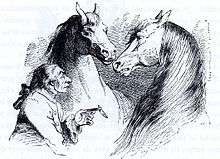
- 7 September 1710 – 5 December 1715
Despite his earlier intention of remaining at home, Gulliver returns to sea as the captain of a merchantman, as he is bored with his employment as a surgeon. On this voyage, he is forced to find new additions to his crew who, he believes, have turned against him. His crew then commits mutiny. After keeping him contained for some time, they resolve to leave him on the first piece of land they come across, and continue as pirates. He is abandoned in a landing boat and comes upon a race of deformed savage humanoid creatures to which he conceives a violent antipathy. Shortly afterwards, he meets the Houyhnhnms, a race of talking horses. They are the rulers while the deformed creatures that resemble human beings are called Yahoos.
Gulliver becomes a member of a horse's household and comes to both admire and emulate the Houyhnhnms and their way of life, rejecting his fellow humans as merely Yahoos endowed with some semblance of reason which they only use to exacerbate and add to the vices Nature gave them. However, an Assembly of the Houyhnhnms rules that Gulliver, a Yahoo with some semblance of reason, is a danger to their civilization and commands him to swim back to the land that he came from. Gulliver's "Master," the Houyhnhnm who took him into his household, buys him time to create a canoe to make his departure easier. After another disastrous voyage, he is rescued against his will by a Portuguese ship. He is disgusted to see that Captain Pedro de Mendez, whom he considers a Yahoo, is a wise, courteous, and generous person.
He returns to his home in England, but is unable to reconcile himself to living among "Yahoos" and becomes a recluse, remaining in his house, avoiding his family and his wife, and spending several hours a day speaking with the horses in his stables.
It is now generally accepted that the fourth voyage of Gulliver's Travels does embody a wholly pessimistic view of the place of man and the meaning of his existence in the universe.[7]
Composition and history
It is uncertain exactly when Swift started writing Gulliver's Travels. (Much of the writing was done at Loughry Manor in Cookstown, County Tyrone, whilst Swift stayed there.) Some sources suggest as early as 1713 when Swift, Gay, Pope, Arbuthnot and others formed the Scriblerus Club with the aim of satirising popular literary genres. According to these accounts, Swift was charged with writing the memoirs of the club's imaginary author, Martinus Scriblerus, and also with satirising the "travellers' tales" literary subgenre. It is known from Swift's correspondence that the composition proper began in 1720 with the mirror-themed Parts I and II written first, Part IV next in 1723 and Part III written in 1724; but amendments were made even while Swift was writing Drapier's Letters. By August 1725 the book was complete; and as Gulliver's Travels was a transparently anti-Whig satire, it is likely that Swift had the manuscript copied so that his handwriting could not be used as evidence if a prosecution should arise, as had happened in the case of some of his Irish pamphlets (the Drapier's Letters). In March 1726 Swift travelled to London to have his work published; the manuscript was secretly delivered to the publisher Benjamin Motte, who used five printing houses to speed production and avoid piracy.[8] Motte, recognising a best-seller but fearing prosecution, cut or altered the worst offending passages (such as the descriptions of the court contests in Lilliput and the rebellion of Lindalino), added some material in defence of Queen Anne to Part II, and published it. The first edition was released in two volumes on 28 October 1726, priced at 8s. 6d.[9]
Motte published Gulliver's Travels anonymously, and as was often the way with fashionable works, several follow-ups (Memoirs of the Court of Lilliput), parodies (Two Lilliputian Odes, The first on the Famous Engine With Which Captain Gulliver extinguish'd the Palace Fire...) and "keys" (Gulliver Decipher'd and Lemuel Gulliver's Travels into Several Remote Regions of the World Compendiously Methodiz'd, the second by Edmund Curll who had similarly written a "key" to Swift's Tale of a Tub in 1705) were swiftly produced. These were mostly printed anonymously (or occasionally pseudonymously) and were quickly forgotten. Swift had nothing to do with them and disavowed them in Faulkner's edition of 1735. Swift's friend Alexander Pope wrote a set of five Verses on Gulliver's Travels, which Swift liked so much that he added them to the second edition of the book, though they are rarely included.
Faulkner's 1735 edition
In 1735 an Irish publisher, George Faulkner, printed a set of Swift's works, Volume III of which was Gulliver's Travels. As revealed in Faulkner's "Advertisement to the Reader", Faulkner had access to an annotated copy of Motte's work by "a friend of the author" (generally believed to be Swift's friend Charles Ford) which reproduced most of the manuscript without Motte's amendments, the original manuscript having been destroyed. It is also believed that Swift at least reviewed proofs of Faulkner's edition before printing, but this cannot be proved. Generally, this is regarded as the Editio Princeps of Gulliver's Travels with one small exception. This edition had an added piece by Swift, A letter from Capt. Gulliver to his Cousin Sympson, which complained of Motte's alterations to the original text, saying he had so much altered it that "I do hardly know mine own work" and repudiating all of Motte's changes as well as all the keys, libels, parodies, second parts and continuations that had appeared in the intervening years. This letter now forms part of many standard texts.
Lindalino
The five-paragraph episode in Part III, telling of the rebellion of the surface city of Lindalino against the flying island of Laputa, was an obvious allegory to the affair of Drapier's Letters of which Swift was proud. Lindalino represented Dublin and the impositions of Laputa represented the British imposition of William Wood's poor-quality copper currency. Faulkner had omitted this passage, either because of political sensitivities raised by an Irish publisher printing an anti-British satire, or possibly because the text he worked from did not include the passage. In 1899 the passage was included in a new edition of the Collected Works. Modern editions derive from the Faulkner edition with the inclusion of this 1899 addendum.
Isaac Asimov notes in The Annotated Gulliver that Lindalino is generally taken to be Dublin, being composed of double lins; hence, Dublin.[10]
Major themes
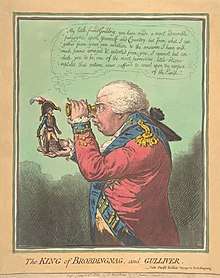
Gulliver's Travels has been the recipient of several designations: from Menippean satire to a children's story, from proto-science fiction to a forerunner of the modern novel.
Published seven years after Daniel Defoe's successful Robinson Crusoe, Gulliver's Travels may be read as a systematic rebuttal of Defoe's optimistic account of human capability. In The Unthinkable Swift: The Spontaneous Philosophy of a Church of England Man, Warren Montag argues that Swift was concerned to refute the notion that the individual precedes society, as Defoe's novel seems to suggest. Swift regarded such thought as a dangerous endorsement of Thomas Hobbes' radical political philosophy and for this reason Gulliver repeatedly encounters established societies rather than desolate islands. The captain who invites Gulliver to serve as a surgeon aboard his ship on the disastrous third voyage is named Robinson.
Scholar Allan Bloom points out that Swift's critique of science (the experiments of Laputa) is the first such questioning by a modern liberal democrat of the effects and cost on a society which embraces and celebrates policies pursuing scientific progress.[11] Swift wrote:
The first man I saw was of a meagre aspect, with sooty hands and face, his hair and beard long, ragged, and singed in several places. His clothes, shirt, and skin, were all of the same colour. He has been eight years upon a project for extracting sunbeams out of cucumbers, which were to be put in phials hermetically sealed, and let out to warm the air in raw inclement summers. He told me, he did not doubt, that, in eight years more, he should be able to supply the governor’s gardens with sunshine, at a reasonable rate: but he complained that his stock was low, and entreated me “to give him something as an encouragement to ingenuity, especially since this had been a very dear season for cucumbers.” I made him a small present, for my lord had furnished me with money on purpose, because he knew their practice of begging from all who go to see them.
A possible reason for the book's classic status is that it can be seen as many things to many different people. Broadly, the book has three themes:
- A satirical view of the state of European government, and of petty differences between religions
- An inquiry into whether men are inherently corrupt or whether they become corrupted
- A restatement of the older "ancients versus moderns" controversy previously addressed by Swift in The Battle of the Books
In storytelling and construction the parts follow a pattern:
- The causes of Gulliver's misadventures become more malignant as time goes on—he is first shipwrecked, then abandoned, then attacked by strangers, then attacked by his own crew.
- Gulliver's attitude hardens as the book progresses—he is genuinely surprised by the viciousness and politicking of the Lilliputians but finds the behaviour of the Yahoos in the fourth part reflective of the behaviour of people.
- Each part is the reverse of the preceding part—Gulliver is big/small/wise/ignorant, the countries are complex/simple/scientific/natural, and the forms of government are worse/better/worse/better than Britain's.
- Gulliver's viewpoint between parts is mirrored by that of his antagonists in the contrasting part—Gulliver sees the tiny Lilliputians as being vicious and unscrupulous, and then the king of Brobdingnag sees Europe in exactly the same light; Gulliver sees the Laputians as unreasonable, and his Houyhnhnm master sees humanity as equally so.
- No form of government is ideal—the simplistic Brobdingnagians enjoy public executions and have streets infested with beggars, the honest and upright Houyhnhnms who have no word for lying are happy to suppress the true nature of Gulliver as a Yahoo and are equally unconcerned about his reaction to being expelled.
- Specific individuals may be good even where the race is bad—Gulliver finds a friend in each of his travels and, despite Gulliver's rejection and horror toward all Yahoos, is treated very well by the Portuguese captain, Don Pedro, who returns him to England at the novel's end.
Of equal interest is the character of Gulliver himself—he progresses from a cheery optimist at the start of the first part to the pompous misanthrope of the book's conclusion and we may well have to filter our understanding of the work if we are to believe the final misanthrope wrote the whole work. In this sense, Gulliver's Travels is a very modern and complex novel. There are subtle shifts throughout the book, such as when Gulliver begins to see all humans, not just those in Houyhnhnm-land, as Yahoos.[12]
Throughout, Gulliver is presented as being gullible. He generally accepts what he is told at face value; he rarely perceives deeper meanings; and he is an honest man who expects others to be honest. This makes for fun and irony: what Gulliver says can be trusted to be accurate, and he does not always understand the meaning of what he perceives.
Also, although Gulliver is presented as a commonplace "everyman" with only a basic education, he possesses a remarkable natural gift for language. He quickly becomes fluent in the native tongues of the strange lands in which he finds himself, a literary device that adds verisimilitude and humour to Swift's work.
Despite the depth and subtlety of the book, as well as frequent off-colour and black humour, it is often mistakenly classified as a children's story because of the popularity of the Lilliput section (frequently bowdlerised) as a book for children. Indeed, many adaptations of the story are squarely aimed at a young audience, and one can still buy books entitled Gulliver's Travels which contain only parts of the Lilliput voyage, and occasionally the Brobdingnag section.
Misogyny
Swift uses satire to openly mock misogyny throughout the book, with one of the most cited examples of this coming from Gulliver's description of a Brobdingnagian woman:
- "I must confess no Object ever disgusted me so much as the Sight of her monstrous Breast, which I cannot tell what to compare with, so as to give the curious Reader an Idea of its Bulk, Shape, and Colour.... This made me reflect upon the fair Skins of our English Ladies, who appear so beautiful to us, only because they are of our own Size, and their Defects not to be seen but through a magnifying glass...."
This open critique towards aspects of the female body is something that Swift often brings up in other works of his, particularly in poems such as The Lady's Dressing Room and A Beautiful Young Nymph Going To Bed.[13]
A criticism of Swift's use of misogyny by Felicity A. Nussbaum proposes the idea that “Gulliver himself is a gendered object of satire, and his antifeminist sentiments may be among those mocked.” Gulliver’s own masculinity is often mocked, seen in how he is made to be a coward among the Brobdingnag people, repressed by the people of Lilliput, and viewed as an inferior Yahoo among the Houyhnhnms.[12]
Nussbaum goes on to say in her analysis of the misogyny of the stories that in the adventures, particularly in the first story, the satire isn't singularly focussed on satirizing women, but to satirize Gulliver himself as a politically naive and inept giant whose masculine authority comically seems to be in jeopardy [14]
Another criticism of Swift's use of misogyny delves into Gulliver's repeated use of the word 'nauseous,' and the way that Gulliver is fighting his emasculation by commenting on how he thinks the women of Brobdingnag are disgusting.
- "Swift has Gulliver frequently invoke the sensory (as opposed to reflective) word "nauseous" to describe this and other magnified images in Brobdingnag not only to reveal the neurotic depths of Gulliver's misogyny, but also to show how male nausea can be used as a pathetic countermeasure against the perceived threat of female consumption. Swift has Gulliver associate these magnified acts of female consumption with the act of "throwing-up"—the opposite of and antidote to the act of gastronomic consumption."[15]
This commentary of Deborah Needleman Armintor relies upon the way that the giant women do with Gulliver as they please, in much the same way as one might play with a toy, and get it to do everything one can think of. Armintor's comparison focuses on the pocket microscopes that were popular in Swift's time. She talks about how this instrument of science was transitioned to something toy-like and accessible, so it shifted into something that women favored, and thus men lose interest. This is similar to the progression of Gulliver's time in Brobdingnag, from man of science to women's plaything.
Comic misanthropy
Misanthropy is a theme that scholars have identified in Gulliver's Travels. Arthur Case, R.S. Crane, and Edward Stone discuss Gulliver's development of misanthropy and come to the consensus that this theme ought to be viewed as comical rather than cynical.[16][17][18]
In terms of Gulliver's development of misanthropy, these three scholars point to the fourth voyage. According to Case, Gulliver is at first averse to identifying with the Yahoos, but, after he deems the Houyhnhnms superior, he comes to believe that humans (including his fellow Europeans) are Yahoos due to their shortcomings. Perceiving the Houyhnhnms as perfect, Gulliver thus begins to perceive himself and the rest of humanity as imperfect.[16] According to Crane, when Gulliver develops his misanthropic mindset, he becomes ashamed of humans and views them more in line with animals.[17] This new perception of Gulliver's, Stone claims, comes about because the Houyhnhnms' judgement pushes Gulliver to identify with the Yahoos.[18] Along similar lines, Crane holds that Gulliver's misanthropy is developed in part when he talks to the Houyhnhnms about mankind because the discussions lead him to reflect on his previously held notion of humanity. Specifically, Gulliver’s master, who is a Houyhnhnm, provides questions and commentary that contribute to Gulliver’s reflectiveness and subsequent development of misanthropy.[17] However, Case points out that Gulliver's dwindling opinion of humans may be blown out of proportion due to the fact that he is no longer able to see the good qualities that humans are capable of possessing. Gulliver’s new view of humanity, then, creates his repulsive attitude towards his fellow humans after leaving Houyhnhnmland.[16] But in Stone's view, Gulliver’s actions and attitude upon his return can be interpreted as misanthropy that is exaggerated for comic effect rather than for a cynical effect. Stone further suggests that Gulliver goes mentally mad and believes that this is what leads Gulliver to exaggerate the shortcomings of humankind.[18]
Another aspect that Crane attributes to Gulliver’s development of misanthropy is that when in Houyhnhnmland, it is the animal-like beings (the Houyhnhnms) who exhibit reason and the human-like beings (the Yahoos) who seem devoid of reason; Crane argues that it is this switch from Gulliver’s perceived norm that leads the way for him to question his view of humanity. As a result, Gulliver begins to identify humans as a type of Yahoo. To this point, Crane brings up the fact that a traditional definition of man—Homo est animal rationale (Humans are rational animals)—was prominent in academia around Swift’s time. Furthermore, Crane argues that Swift had to study this type of logic (see Porphyrian Tree) in college, so it is highly likely that he intentionally inverted this logic by placing the typically given example of irrational beings—horses—in the place of humans and vice versa.[17]
Stone points out that Gulliver's Travels takes a cue from the genre of the travel book, which was popular during Swift's time period. From reading travel books, Swift’s contemporaries were accustomed to beast-like figures of foreign places; thus, Stone holds that the creation of the Yahoos was not out of the ordinary for the time period. From this playing off of familiar genre expectations, Stone deduces that the parallels that Swift draws between the Yahoos and humans is meant to be humorous rather than cynical. Even though Gulliver sees Yahoos and humans as if they are one and the same, Stone argues that Swift did not intend for readers to take on Gulliver’s view; Stone states that the Yahoos’ behaviors and characteristics that set them apart from humans further supports the notion that Gulliver's identification with Yahoos is not meant to be taken to heart. Thus, Stone sees Gulliver’s perceived superiority of the Houyhnhnms and subsequent misanthropy as features that Swift used to employ the satirical and humorous elements characteristic of the Beast Fables of travel books that were popular with his contemporaries; as Swift did, these Beast Fables placed animals above humans in terms of morals and reason, but they were not meant to be taken literally.[18]
Character analysis
Pedro de Mendez is the name of the Portuguese captain who rescues Gulliver in Book IV. When Gulliver is forced to leave the Island of the Houyhnhnms, his plan is "to discover some small Island uninhabited" where he can live in solitude. Instead, he is picked up by Don Pedro's crew. Despite Gulliver's appearance—he is dressed in skins and speaks like a horse—Don Pedro treats him compassionately and returns him to Lisbon.
Though Don Pedro appears only briefly, he has become an important figure in the debate between so-called soft school and hard school readers of Gulliver's Travels. Some critics contend that Gulliver is a target of Swift's satire and that Don Pedro represents an ideal of human kindness and generosity. Gulliver believes humans are similar to Yahoos in the sense that they make "no other use of reason, than to improve and multiply...vices" [19] Captain Pedro provides a contrast to Gulliver's reasoning, proving humans are able to reason, be kind, and most of all: civilized. Gulliver sees the bleak fallenness at the center of human nature, and Don Pedro is merely a minor character who, in Gulliver's words, is "an Animal which had some little Portion of Reason".[20]
Reception
The book was very popular upon release and was commonly discussed within social circles.[21] Public reception widely varied, with the book receiving an initially enthusiastic reaction with readers praising its satire, and some reporting that the satire's cleverness sounded like a realistic account of a man's travels.[22] James Beattie commended Swift’s work for its “truth” regarding the narration and claims that “the statesman, the philosopher, and the critick, will admire his keenness of satire, energy of description, and vivacity of language,” noting that even children can enjoy the novel.[23] As popularity increased, critics came to appreciate the deeper aspects of Gulliver’s Travels. It became known for its insightful take on morality, expanding its reputation beyond just humorous satire.[22]
Despite its initial positive reception, the book faced backlash. One of the first critics of the book, referred to as Lord Bolingbroke, criticized Swift for his overt use of misanthropy.[22] Other negative responses to the novel also looked towards its portrayal of humanity, which was considered inaccurate. Swifts’s peers rejected the novel on claims that its themes of misanthropy were harmful and offensive. They criticized its satire for exceeding what was deemed acceptable and appropriate, including the Houyhnhnms and Yahoos’s similarities to humans.[23] There was also controversy surrounding the political allegories. Readers enjoyed the political references, finding them humorous. However, members of the Whig party were offended, believing that Swift mocked their politics.[22]
British novelist and journalist William Makepeace Thackeray described Swift's novel as "blasphemous", citing its critical view of mankind as ludicrous and overly harsh. He concludes his critique by remarking that he cannot understand the origins of Swift’s critiques on humanity.[23]
Cultural influences
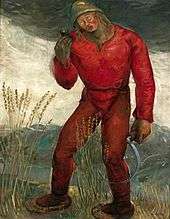
The term Lilliputian has entered many languages as an adjective meaning "small and delicate". There is a brand of small cigar called Lilliput, and a series of collectable model houses known as "Lilliput Lane". The smallest light bulb fitting (5 mm diameter) in the Edison screw series is called the "Lilliput Edison screw". In Dutch and Czech, the words Lilliputter and lilipután, respectively, are used for adults shorter than 1.30 meters. Conversely, Brobdingnagian appears in the Oxford English Dictionary as a synonym for very large or gigantic.
In like vein, the term yahoo is often encountered as a synonym for ruffian or thug. In the Oxford English Dictionary it is considered a definition for "a rude, noisy, or violent person" and its origins attributed to Swift's Gulliver's Travels.[24]
In the discipline of computer architecture, the terms big-endian and little-endian are used to describe two possible ways of laying out bytes in memory. The terms derive from one of the satirical conflicts in the book, in which two religious sects of Lilliputians are divided between those who crack open their soft-boiled eggs from the little end, the "Little-endians", and those who use the big end, the "Big-endians".
In other works
Many sequels followed the initial publishing of the Travels. The earliest of these was the anonymously authored Memoirs of the Court of Lilliput,[25] published 1727, which expands the account of Gulliver's stays in Lilliput and Blefuscu by adding several gossipy anecdotes about scandalous episodes at the Lilliputian court. Abbé Pierre Desfontaines, the first French translator of Swift's story, wrote a sequel, Le Nouveau Gulliver ou Voyages de Jean Gulliver, fils du capitaine Lemuel Gulliver (The New Gulliver, or the travels of John Gulliver, son of Captain Lemuel Gulliver), published in 1730.[26] Gulliver's son has various fantastic, satirical adventures.
Bibliography
Editions
The standard edition of Jonathan Swift's prose works as of 2005 is the Prose Writings in 16 volumes, edited by Herbert Davis et al.[27]
- Swift, Jonathan Gulliver's Travels (Harmondsworth: Penguin, 2008) ISBN 978-0141439495. Edited with an introduction and notes by Robert DeMaria Jr. The copytext is based on the 1726 edition with emendations and additions from later texts and manuscripts.
- Swift, Jonathan Gulliver's Travels (Oxford: Oxford University Press, 2005) ISBN 978-0192805348. Edited with an introduction by Claude Rawson and notes by Ian Higgins. Essentially based on the same text as the Essential Writings listed below with expanded notes and an introduction, although it lacks the selection of criticism.
- Swift, Jonathan The Essential Writings of Jonathan Swift (New York: W.W. Norton, 2009) ISBN 978-0393930658. Edited with an introduction by Claude Rawson and notes by Ian Higgins. This title contains the major works of Swift in full, including Gulliver's Travels, A Modest Proposal, A Tale of a Tub, Directions to Servants and many other poetic and prose works. Also included is a selection of contextual material, and criticism from Orwell to Rawson. The text of GT is taken from Faulkner's 1735 edition.
- Swift, Jonathan Gulliver's Travels (New York: W.W. Norton, 2001) ISBN 0393957241. Edited by Albert J. Rivero. Based on the 1726 text, with some adopted emendations from later corrections and editions. Also includes a selection of contextual material, letters, and criticism.
See also
- Aeneid
- List of literary cycles
- Odyssey
- Sinbad the Sailor
- Sunpadh
- The Voyage of Bran
References
- Swift, Jonathan (2003). DeMaria, Robert J (ed.). Gulliver's Travels. Penguin. p. xi.
- Swift, Jonathan (2009). Rawson, Claude (ed.). Gulliver's Travels. W. W. Norton. p. 875. ISBN 978-0-393-93065-8.
- Gay, John. "Letter to Jonathan Swift". Communion. Communion Arts Journal. Retrieved 9 January 2019.
- "The 100 best novels written in English: the full list". Retrieved 17 August 2015.
- Case, Arthur Ellicott (1945). Four essays on Gulliver's travels. Gloucester, MA: P. Smith.
- On File:Map_of_Lilliput_-_Gulliver's_Travels_1726_edition.png from the first edition of Gulliver's Travels, Lilliput clearly lies to the west of Australia, to the southwest of Sumatra, and to the northwest of Dimen's Land (Tasmania). However, New Holland (Australia) is seen to be omitted there. Compare Herman Moll's 1697 map, cropped to File:Moll - A map of the world shewing the course of Mr Dampiers voyage round it from 1679 to 1691 (cropped) - New Holland - Dimens Land.png.
- Jan, Firdaus, K. M., Shabam (2004). Perspectives on Gulliver's Travels. p. 17.
- Clive Probyn, Swift, Jonathan (1667–1745), Oxford Dictionary of National Biography (Oxford University Press: Oxford, 2004)
- Daily Journal 28 Oct 1726, "This day is published".
- Swift, Jonathan (1980). Isaac Asimov (ed.). The Annotated Gulliver's Travels. New York: Clarkson N Potter Inc. p. 160. ISBN 0-517-539497.
- Allan Bloom (1990). Giants and Dwarfs: An Outline of Gulliver's Travels. New York: Simon and Schuster. pp. 47–51.
- Swift, Jonathan (1994). Gulliver's travels : complete, authoritative text with biographical and historical contexts, critical history, and essays from five contemporary critical perspectives. Fox, Christopher. Boston. ISBN 978-0312066659. OCLC 31794911.
- Rogers, Katharine M. (1959). "'My Female Friends': The Misogyny of Jonathan Swift". Texas Studies in Literature and Language. 1 (3): 366–79. JSTOR 40753638.
- Swift, Jonathan (1995). Gulliver's travels : complete, authoritative text with biographical and historical contexts, critical history, and essays from five contemporary critical perspectives. Fox, Christopher. Boston. ISBN 0-312-10284-4. OCLC 31794911.
- Armintor, Deborah Needleman (2007). "The Sexual Politics of Microscopy in Brobdingnag". SEL: Studies in English Literature 1500–1900. 47 (3): 619–40. doi:10.1353/sel.2007.0022. JSTOR 4625129.
- Case, Arthur E. “From ‘The Significance of Gulliver’s Travels.’” A Casebook on Gulliver Among the Houyhnhnms, edited by Milton P. Foster, Thomas Y. Crowell Company, 1961, pp. 139–47.
- Crane, R.S. “The Houyhnhnms, the Yahoos, and the History of Ideas.” Twentieth Century Interpretations of Gulliver’s Travels: A Collection of Critical Essays, edited by Frank Brady, Englewood Cliffs, NJ, Prentice-Hall, 1968, pp. 80–88.
- Stone, Edward. “Swift and the Horses: Misanthropy or Comedy?” A Casebook on Gulliver Among the Houyhnhnms, edited by Milton P. Foster, Thomas Y. Crowell Company, 1961, pp. 180–92.
- Swift, Jonathan (1726). Gulliver's Travels. p. 490. ISBN 978-0-393-93065-8.
- James Clifford, "Gulliver's Fourth Voyage: 'hard' and 'soft' Schools of Interpretation". Quick Springs of Sense: Studies in the Eighteenth Century. Ed. Larry Champion. Athens: U of Georgia Press, 1974. 33–49
- Wiener, Gary, editor. "The Enthusiastic Reception of Gulliver's Travels". Readings on Gulliver's Travels, Greenhaven Press, 2000, pp. 57–65.
- Gerace, Mary. “The Reputation of ‘Gulliver’s Travels’ in the Eighteenth Century.” University of Windsor, 1967.
- Lund, Roger D. Johnathan Swift’s Gulliver's Travels: A Routledge Study Guide. Routledge, 2006.
- "yahoo – definition of yahoo in English". Oxford Dictionaries.
- "Memoirs of the Court of Lilliput". J. Roberts. 1727 – via Google Books.
- l'abbé), Desfontaines (Pierre-François Guyot, M.; Swift, Jonathan (1730). "Le nouveau Gulliver: ou, Voyage de Jean Gulliver, fils du capitaine Gulliver". La veuve Clouzier – via Google Books.
- Swift, Jonathan (2005). Rawson, Claude; Higgins, Ian (eds.). Gulliver's Travels (New ed.). Oxford. p. xlviii.
External links
| Wikisource has original text related to this article: |
| Wikiquote has quotations related to: Gulliver's Travels |
| Wikimedia Commons has media related to Gulliver's Travels. |
Online text
- Gulliver's Travels at Project Gutenberg (1727 ed.)
- Gulliver's Travels at Project Gutenberg (1900 ed.; with illustrations)
- Gulliver's Travels at the Internet Archive
Other

- Gulliver's Travels Map
